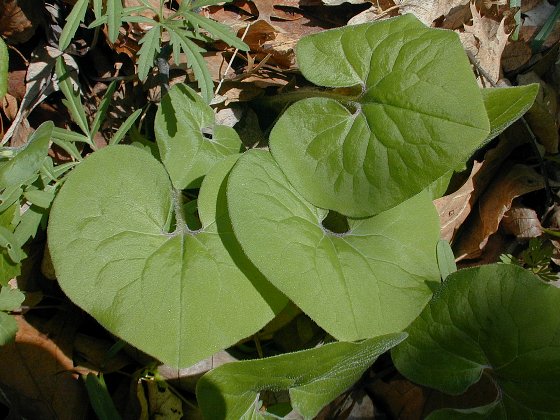 Description:
This
herbaceous perennial plant is 4-12" tall, consisting of a short stem
that
branches at ground level into 2 basal leaves with long petioles. The
basal leaves are up to 3" long and 4" across. They are
cordate-orbicular, deeply
indented
at the base, and have smooth margins. Their upper surface is slightly
hairy and shiny. From the axil of a pair of leaves, develops a single
reddish brown flower on a short stalk. Both the flowering stalk and the
petioles of the leaves are covered with white hairs that are long and
twisted. The flower is about 1" across; it has 3 calyx lobes that are
triangular in shape and curl backward. The thick tubular base of calyx
is divided into 6 rounded chambers (3 primary chambers, which are each
divided into 2 secondary chambers). These chambers contain the ovaries,
which develop into rows of seeds. The tubular base of the calyx is
light reddish brown and covered with long white hairs. There is a stout
column of reproductive organs at the throat of the flower, which is
reddish brown like the lobes. It is surrounded by the inner surface of
the calyx, which is white. The blooming period occurs from mid- to late
spring, and lasts about 3 weeks. After the flowers wither away, the
seed capsule splits open to release the seeds. These seeds have a
fleshy appendage. The root system consists of shallow rhizomes that are
fleshy and branching. This plant often forms vegetative colonies.
Description:
This
herbaceous perennial plant is 4-12" tall, consisting of a short stem
that
branches at ground level into 2 basal leaves with long petioles. The
basal leaves are up to 3" long and 4" across. They are
cordate-orbicular, deeply
indented
at the base, and have smooth margins. Their upper surface is slightly
hairy and shiny. From the axil of a pair of leaves, develops a single
reddish brown flower on a short stalk. Both the flowering stalk and the
petioles of the leaves are covered with white hairs that are long and
twisted. The flower is about 1" across; it has 3 calyx lobes that are
triangular in shape and curl backward. The thick tubular base of calyx
is divided into 6 rounded chambers (3 primary chambers, which are each
divided into 2 secondary chambers). These chambers contain the ovaries,
which develop into rows of seeds. The tubular base of the calyx is
light reddish brown and covered with long white hairs. There is a stout
column of reproductive organs at the throat of the flower, which is
reddish brown like the lobes. It is surrounded by the inner surface of
the calyx, which is white. The blooming period occurs from mid- to late
spring, and lasts about 3 weeks. After the flowers wither away, the
seed capsule splits open to release the seeds. These seeds have a
fleshy appendage. The root system consists of shallow rhizomes that are
fleshy and branching. This plant often forms vegetative colonies.
Cultivation:
The preference is light shade and moist to slightly dry conditions. The
soil should be rich and loamy, although some rocky material underneath
the soil surface is acceptable.
Range & Habitat:
The native Wild Ginger is a common plant that can be found in most
counties of
Illinois (see Distribution
Map). Habitats include moist to slightly dry deciduous
woodlands (both floodplain and upland), and bluffs. It often found
along ravines and slopes.
Faunal Associations:
The reddish brown flowers probably attract flies or beetles as
pollinating agents. The seeds attract ants because of their fleshy
appendages; these insects help to disperse the seeds. The toxic foliage
is not eaten by mammalian herbivores.

Photographic
Location:
The edge of a wooded bluff at Kickapoo State Park in Vermilion County,
Illinois, where this plant is quite common. The foliage in the upper
left corner of the photograph of the basal leaves is Dentaria laciniata
(Cutleaf Toothwort).
Comments:
This plant is called 'Wild Ginger' because the aromatic rhizomes have a
ginger-like fragrance and flavor. Fresh or dried, they can be used as a
substitute for the spice. Different varieties of Wild Ginger have been
described by different authorities, which vary according to the length
of the calyx lobes, and whether they are spreading or reflexed. The
variety that is described here, Asarum canadense reflexum,
is the most common variety of Wild Ginger in Illinois.